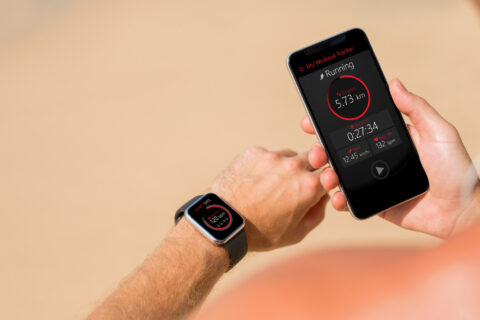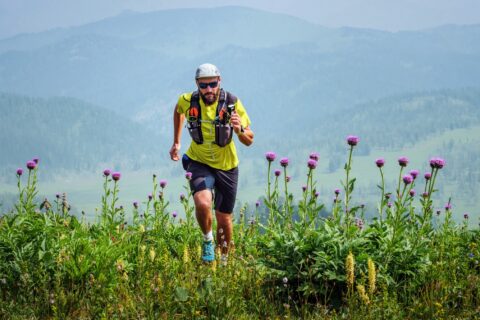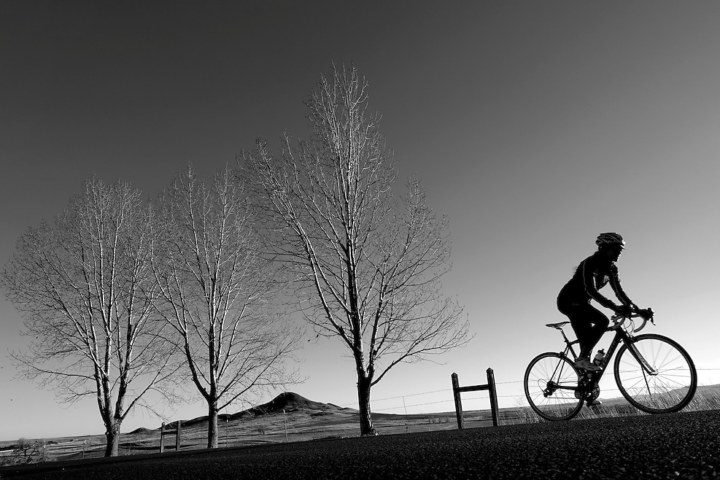Given the variable power demands of mountain biking—often a function of rapid, significant terrain changes—is it possible to do a base ride on the mountain bike?
This question was posed on the Fast Talk Labs forum. Specifically, member Steve Herman asked:
“As an off-road focused athlete, I really feel the need to incorporate MTB into my base training. It’s less boring, not as cold in the winter, and I get some skills work at the same time.
“But the fundamental principle of aerobic base rides is having a steady effort which is very difficult to manage on singletrack. Between the turns and keeping momentum over terrain, MTB is inherently stochastic in its power demands.
“While I can easily keep a very low heart rate on the road, for a similar ‘feeling’ ride, my heart rate will be easily 10-15 beats per minute higher on the MTB.
“Is the LSD impossible on the MTB trail? Is the higher heart rate relative to road riding a problem or simply a result of the greater contribution of the upper body in MTB?”
Coaches Ryan Kohler and Trevor Connor break down the different types of ride you can do to get your base miles—from Zwift to the road to the trails—and specific things you can do on your MTB rides to make them more productive, consistent, and appropriate for the base period.
Video Transcript
Chris Case 00:16
Welcome to Fast Talk Laboratories, your source for the science of cycling performance.
What Are Different Ways to Do A Base Ride?
Ryan Kohler 00:25
Hey everybody, Coach Ryan here with Coach Trevor. And today we’re gonna talk to you about base rides, again-we talk a lot about base rides.- So this one is specifically about base riding on the mountain bike. So we had a forum question that asked about this, it was more along the lines of is it possible? Number one, but then how do you do this? So I wanted to start this one off with looking at, probably the easiest way to do a base ride is on your trainer. So this file right here is a Zwift ride. And if we look at the progression of basically all the metrics, they’re pretty darn flat. So we see power here, in pink, pretty consistent throughout, we see this heart rate line in red, very, very consistent. And we see the cadence here also very, very consistent. So we have these indoor rides, where it’s just very easy to maintain our effort. And there’s not much too kind of get thrown at us to mix that up. So then if we take that outdoors, this is a road ride. And you know, a little more variation in terrain, we can see down here in the gray, power you can see jumps around a little bit more, there’s a couple of breaks in there. And then heart rate is relatively even, we see some definite drift toward the end there. But if we look overall, at the effort, heart rate, on average is about 117. So fairly low. And we start to see some of these higher numbers creep in here toward the end when the heart rate drifts up. So fairly consistent, I’ll say. But the question is, can we do this on the mountain bike, let’s go to a mountain bike file. This is a local loop that has -this is kind of a mix of dirt, mountain bike trails, double tracks, single track, so it has a little bit of everything. -One thing you want to focus on initially is just the heart rate, right? So we look at the heart rate from this road ride. And we can see we averaged about 117, so well within that base effort there. We go over here. And we have same average 117. Great. So the difference, though, is we see a lot more variability in the heart rate as we go through this. And of course, that’s related to the terrain, you can see it’s going to be fairly hilly terrain, there’s going to be some steeper sections like I said, single track, there might be loose dirt that we’re contending with. So when we are thinking about how to best achieve a base ride on the mountain bike, I think the terrain is a huge, huge factor. What do you think, Trevor, looking at this? You do a lot of very nicely controlled, long, steady rides, and you have great heart rate control. So what do you think about this base riding on the dirt?
Trevor Connor 03:13
Well, I gotta say, I thought I did. I have an athlete I’m coaching who has been obsessed with his variability index. And he did a four-hour ride with the variability index of 0.99, which I didn’t think was possible. So I went out for a ride with him. He’s like, why are you being so surgey? So you can always get better, being the point. And there might be a point where you go, you’re getting too good at this don’t be a robot. Starting with your mountain bike ride here, a couple of things I look at. We got asked by one of our members not that long ago about whether you can do base mile rides on the mountain bike. And while you pointed out that heart rate isn’t as steady here. The other thing I’ve noticed is you’ve got cadence turned on, which is the yellow, and you can certainly see that’s not nearly as steady as you were on the trainer or on the road. But notice the highest heart rate you hit here was 142, where I think on the road ride outside you actually hit 146
Ryan Kohler 04:15
Right.
How Can A Mountain Bike Ride Be a Base Ride?
Trevor Connor 04:16
Even though it wasn’t a steady ride, you are still very careful on this mountain bike ride about keeping it in the right ranges. whenever you go up mountain biking you’re good to hit some tough a little climbs, some tough little parts, you are careful about not trying to hit those as hard as you could and suddenly get your heart rate up into the 170s. So I still look at this and go this is a good base miles ride. Not physiologically probably as good as being out on the road or on the trainer. But there is a mental component and if all you’re ever doing is sitting on the trainer at one wattage, one heart rate, it gets really boring really quickly and this ride probably was quite enjoyable. And when I work with an athlete and they’re getting bored, I tell him go out and do this stuff. Just don’t hit those climbs as hard as you can, don’t start seeing those 170-180 heart rates. But I’m okay with that less consistency and have some fun with it. Can we take a look at the Zwift ride?
Ryan Kohler 05:21
Sure. There we go.
Trevor Connor 05:24
So here, yeah, you could really see on Zwift just how consistent you can be. So there you go, variability index 1.01. That’s impressive. Look at the cadence, you can see that that is also nearly a flatline. So there’s real benefits of this. But I have to ask you, when you did this ride, was it getting pretty boring?
Ryan Kohler 05:48
That’s why it was only 45 minutes, I think.
Trevor Connor 05:51
There you go. So we get asked about this ride. You tell me what you feel. But my response is yes, physiologically, there’s some benefits to this. But mentally this can really wear on you. So it’s always a give and take. And the way you did that mountain bike ride, it was probably more enjoyable. I would certainly like to see an athlete, do maybe a little bit of this, but also getting out on that mountain bike and just enjoying the riding.
Ryan Kohler 06:22
Yeah, I think that’s great. This kind of ride, like you said, it’s a mental component too and that’s pretty much why they’re 45 to 60 minutes is it’s just hard to do much more than that. So I’ll tend to look for more frequency of rides like this. So if I can do a morning and an evening of 45 minutes apiece, great. Now I’ve accumulated more time like this, and it’s not as troubling to sit on the trainer for 90 minutes. But yeah, then having that way to break it up and go out and play on the trails is just huge. Because yeah, then you can go out cover a little more distance and just spend two and a half hours on the bike. I think whenever an athlete is kind of asking this question, you know, we do talk about terrain, because you see all these drops in cadence, of course, on the descends. But we also want to really be okay, with letting our speed drop, you know mean, this portion of the climb I think is a great example of that was almost four minutes riding at five miles an hour. I mean, how difficult is that right? It’s a 7% grade. So a decent grade, but yeah, how difficult is it to ride at five miles an hour? I mean, There were times that, I was almost passed by people running, but it’s learning to be okay with that is I think the way to accomplish this type of thing. And you can see even at the lowest, we dipped down to three and a half miles an hour, in the steepest section of that. So it’s, learning to be okay with that.
Keep Variability Low
Trevor Connor 07:54
Yep. No, I say that to me, this is really good lesson, I think you’re showing a really good point. Which is, have some fun, don’t get obsessive with I need to be on Zwift I need to be doing that that 1.0 variability index, because it can wear on you, go out and enjoy yourself. But I really liked what you just said, Ryan, which is contain yourself, control yourself when you hit that climb like Ryan has highlighted here. Don’t get up into that 160-170 heart rate range or up close towards whatever your threshold is.
Ryan Kohler 08:30
Yeah, I think so. It’s just to find that happy medium. Like you said, there’s a need for all of these for the steady indoor rides, taking them outdoors where we can put in more time and work on that control and maintain that consistency. But yeah, then just go out and have fun on the dirt sometimes. So yeah.
Trevor Connor 08:50
One other thing I just want to point out, look at your average cadence for this mountain bike ride, you can see it’s 76. So certainly, even though you obviously had some points where cadence was high, you are bogging down a lot. Let’s look at the Zwift ride.
Ryan Kohler 09:07
There we go.
Trevor Connor 09:08
So this one you’re averaging 90 I try when I’m on Zwift just doing a steady ride like this. I try to average up towards 100. The road ride I think you averaged 85.
Ryan Kohler 09:19
Yep.
Trevor Connor 09:20
So the one thing I will push my athletes to do is when they’re on zwift doing that steady ride, or particularly when they’re actually outside doing a road ride like this during the base season. I really want to see them get that cadence up. So I tell them when they’re out on the road, you’re not going to average 100 Because you stopped too much, you hit climbs where your cadence is going to drop a bit, but I tell them, I really want to see you trying to keep your cadence around 100 whenever you’re riding steady. Which means they’re going to average 90-95, depending on the route. On Zwift with that ride, I would have loved to see an athlete average 100 RPM
Ryan Kohler 10:00
Yeah, I agree. I think it’s good to push them up toward that. And it makes for a really good focus. It can turn it into a pretty tricky ride just learning to pedal like that. And, and it is, I think, a shift from how we tend to approach these rides.
Trevor Connor 10:17
Yeah, it gives us something different to work on.
Ryan Kohler 10:20
Yeah, no, exactly. Yeah, I think when we’re left to our own, I think we have that tendency to just mash a bit of a bigger gear and settle in there.
Trevor Connor 10:28
Well, thank you Ryan. Three really good workouts to show our members.
Ryan Kohler 10:34
Yeah, thanks for your input, I think, we got some good analysis out of these three. I think we’ve answered that question. You can do a base ride on the mountain bike, we just need to be aware of the demands, look at the terrain. Be aware of how it’s going to change what the file will look like, even the torque, the cadence, and everything like that, and just how it differs from something on the trainer or the road. So, follow up with that on the forums, I know there’s that discussion that’s going on so go on and jump in there. And we’ll see you next time.





